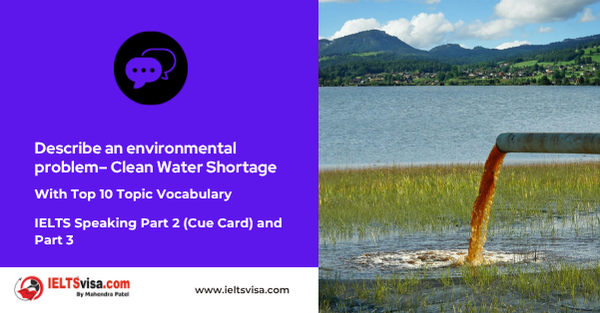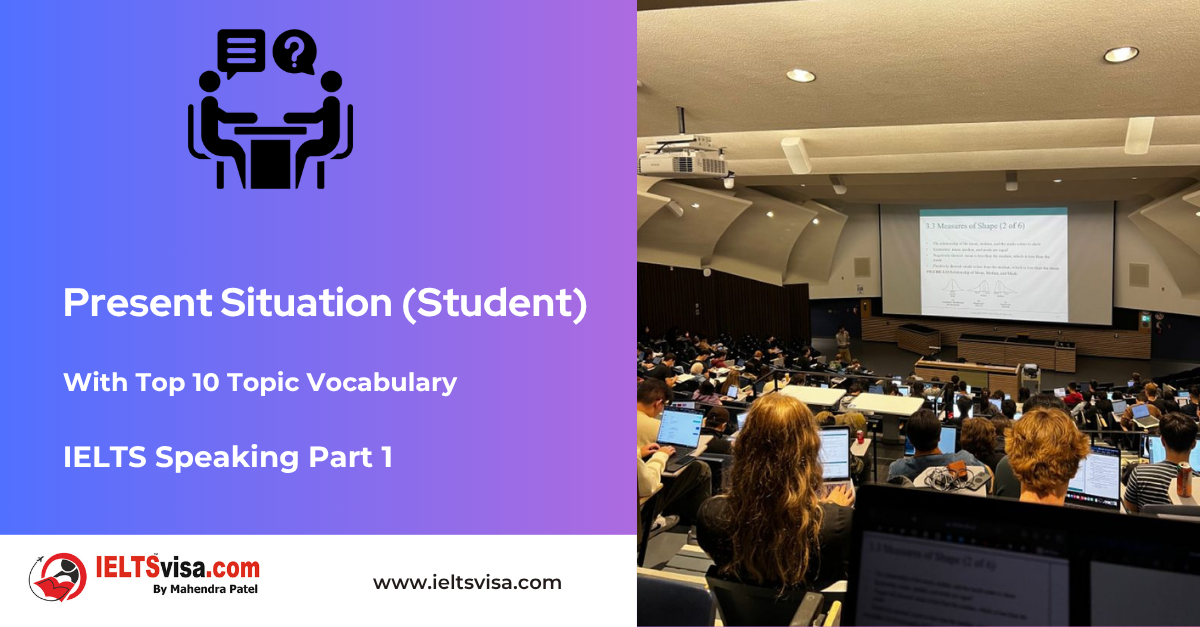Describe an environmental problem – Clean Water Shortage
IELTS Speaking Part 2 (Cue Card) Part 3: Follow-Up Questions
Describe an environmental problem – Clean Water Shortage
🗂️ Part 2 – Cue Card
Describe an environmental problem.
You should say:
- What it is
- How long it has existed
- What effect it has brought to people’s life
And explain what we can do to solve it.
🗣️ Sample Answer
Examiner: You have one to two minutes. Please begin speaking now.
Candidate (Reeva Shah):
One significant environmental issue we face today is the scarcity of clean water. Even though water covers most of the Earth’s surface, only a small percentage is suitable for drinking and daily use.
This issue has existed for decades but has become worse in the last 10–20 years due to population growth, pollution, industrial waste, and climate change. Many areas in India and around the world still lack access to safe and clean drinking water.
The impact of this problem is huge. It affects public health, especially among children. Waterborne diseases, such as cholera and diarrhoea, are common. It also impacts education, as children—especially girls—have to skip school to fetch water. In rural areas, people must walk long distances just to obtain a few litres of water.
To address this, we need to enhance water management, invest in rainwater harvesting, reduce pollution, and promote sustainable conservation practices. Governments should invest in better infrastructure, and individuals must conserve water and help keep rivers and lakes clean.
Clean water should not be a luxury—it’s a basic human right, and we must protect it.
Examiner: Thank you. Have you seen any improvement in your area?
Candidate: Yes, some schools and communities have started installing water filters and collecting rainwater, which is a good step forward.
🔁 Part 3: Follow-Up Questions
1. What causes environmental problems like water scarcity?
Environmental problems, such as water scarcity, are often caused by overpopulation, rapid urbanisation, and inadequate waste management. Industrial discharge and agricultural runoff also contribute to water pollution. Additionally, deforestation and climate change disturb the natural water cycle, worsening the issue.
2. What should governments do to protect the environment?
Governments should implement strict regulations to control pollution and protect natural resources. They must also invest in sustainable infrastructure, such as water treatment plants and rainwater harvesting systems. Raising public awareness through education campaigns is equally important for long-term impact.
3. What can individuals do to help protect the environment?
Individuals can contribute by using water wisely, avoiding single-use plastics, and recycling household waste. They should also participate in community clean-up drives and promote environmental awareness. Every small effort matters when adopted on a large scale.
4. What other measures can help protect the environment?
Promoting renewable energy, incentivising eco-friendly businesses, and creating more green spaces in urban areas are effective strategies. Governments can also ban harmful chemicals and support research in sustainable technologies. International cooperation is essential to address global environmental challenges.
5. How should children be educated about environmental issues?
Children should learn through hands-on activities, such as school gardening and nature-based field trips. Incorporating environmental topics in the curriculum helps them understand the urgency of the issue. Parents and teachers must also serve as role models by practising what they teach.
6. How do the younger and older generations differ in environmental awareness?
Younger generations are more exposed to environmental issues through social media and school education. They are often more proactive and willing to adopt eco-friendly habits. In contrast, older generations may be less aware but tend to follow sustainable practices out of tradition.
7. Do you think environmental issues affect urban and rural areas differently?
Yes, urban areas struggle more with air and industrial pollution, while rural areas face problems like water scarcity and deforestation. Access to environmental resources and awareness levels also differ significantly. Solutions must be tailored to meet the unique needs of each region.
8. How does climate change affect water availability?
Climate change alters rainfall patterns and increases the frequency of droughts, making water less predictable and accessible. Melting glaciers and rising temperatures also impact freshwater sources. As a result, many communities are facing growing challenges in securing safe drinking water.
9. Why is clean water considered a human right?
Clean water is essential for survival, hygiene, and overall health, making it a fundamental necessity. Without it, people are vulnerable to disease and poverty. Recognising it as a human right ensures that everyone, regardless of income or location, has access to this vital resource.
10. Can technology help solve water-related environmental problems?
Yes, technology can play a vital role through innovations such as smart irrigation systems, water purification systems, and leak detection sensors. These tools help conserve water and make clean sources more accessible. Governments and industries must invest in scalable, tech-based solutions for long-term impact.
Top 10 Topic Vocabulary – Describe an environmental problem – Clean Water Shortage
|
Vocabulary |
Type |
Meaning |
Synonyms |
Antonyms |
Word Family |
Example Sentences |
|
Water scarcity |
Noun |
Shortage of usable fresh water |
Drought, water crisis |
Abundance |
Scarce, scarceness |
Water scarcity is a growing concern in many parts of the world. |
|
Contamination |
Noun |
The act of making something impure by adding harmful substances |
Pollution, impurity |
Purity |
Contaminate, contaminated |
Industrial waste leads to water contamination. |
|
Sanitation |
Noun |
Conditions related to clean water and waste disposal |
Hygiene, cleanliness |
Filth |
Sanitary, sanitise |
Poor sanitation causes health problems. |
|
Harvesting |
Noun |
Collecting rainwater for use |
Collecting, gathering |
Wasting |
Harvest, harvested |
Rainwater harvesting can solve water shortages. |
|
Conservation |
Noun |
Protection and careful use of natural resources |
Preservation, saving |
Waste, exploitation |
Conserve, conservative |
Water conservation is critical for sustainability. |
|
Potable |
Adjective |
Safe to drink |
Drinkable, purified |
Contaminated |
— |
Many people lack access to potable water. |
|
Sustainability |
Noun |
Meeting needs without harming future generations |
Eco-balance, longevity |
Unsustainability |
Sustainable, sustainably |
Sustainability should be part of every development plan. |
|
Infrastructure |
Noun |
The basic facilities needed for a society (roads, water, etc.) |
Systems, framework |
Breakdown |
— |
Good infrastructure ensures access to clean water. |
|
Hygiene |
Noun |
Practices that maintain health and cleanliness |
Sanitation, cleanliness |
Neglect |
Hygienic, hygienically |
Clean water is essential for good hygiene. |
|
Awareness |
Noun |
Knowledge or understanding about an issue |
Consciousness, attention |
Ignorance |
Aware, unaware |
Environmental awareness is rising among students. |

Our Books
Master IELTS Speaking Part 1
IELTS Writing Task 1 Book
IELTS Writing Task 2 Book
Practice IELTS Other Modules
IELTS Listening
The IELTS Listening test assesses how well you can understand spoken English in various contexts. It lasts about 30 minutes and is divided into four sections with a total of 40 questions. The listening tasks become increasingly difficult as the test progresses.
IELTS Academic Reading
The IELTS Academic Reading section assesses your ability to understand and interpret a variety of texts in academic settings. It is designed to evaluate a range of reading skills, including skimming for gist, reading for main ideas, reading for detail, understanding inferences, and recognizing a writer's opinions and arguments.
IELTS Speaking
The IELTS Speaking test assesses your ability to communicate in English on everyday topics. It lasts 11-14 minutes and consists of three parts: introduction, cue card, and a discussion based on the cue card topic.
IELTS General Reading
IELTS General Reading tests your ability to understand and interpret various types of texts. Here are some key areas and types of content you can expect to encounter in the reading section, along with tips for effective preparation.
IELTS Academic Writing Task 1
In IELTS Academic Writing Task 1, you are presented with a visual representation of information, such as graphs, charts, tables, or diagrams, and you are required to summarize, compare, or explain the data in your own words.
IELTS General Writing Task 1
In IELTS General Writing Task 1, you are required to write a letter based on a given situation. The letter can be formal, semi-formal, or informal, depending on the prompt. Here’s a breakdown of the key components to include in your letter
IELTS Academic Writing Task 2
In IELTS Academic Writing Task 2, you are required to write an essay in response to a question or topic. Here’s a guide to help you understand the essential elements of this task
IELTS Exam Tips
To succeed in the IELTS exam, practice regularly, familiarize yourself with the test format, improve your vocabulary, develop time management skills, and take mock tests to build confidence.
Grammer for IELTS
Grammar is the foundation of effective communication in English. Understanding tense usage, subject-verb agreement, and sentence structure enhances clarity and coherence in writing and speaking.
Vocabulary for IELTS
Vocabulary plays a crucial role in the IELTS (International English Language Testing System) exam, especially in the Speaking and Writing sections. Here’s an overview of why vocabulary is important and how it impacts your performance
RECENT IELTS SAMPLES QUESTIONS AND ANSWERS
IELTS Speaking Part 1 – Favourite Sujbect – Physics
IELTS Speaking Part 1 - Favourite Sujbect - Physics Q: What is your favourite subject? A: My favourite subject...
IELTS Speaking Part 1 – Present Situation (Student)
IELTS Speaking Part 1 - Present Situation (Student) Q1: Are you a student or do you work?A: I’m a full-time...
IELTS Speaking Part 1 – Present Situation – Employee – as an International Student and Social Worker
IELTS Speaking Part 1 - Present Situation - Employee - as an International Student and Social Worker Q1: Are...
IELTS Speaking Part 1 – Persent Situation – Employee- as an Electric Engineer
IELTS Speaking Part 1 - Persent Situation - Employee- as an Electric Engineer Q1: What do you do for a...
IELTS Speaking Part 1 – Persent Situation – Employee – as an Software Engineer
IELTS Speaking Part 1 - Persent Situation - Employee - as an Software Engineer Q1: What do you do for a...
IELTS Speaking Part 1 – Persent Situation – Married
IELTS Speaking Part 1 - Persent Situation - Married Q1: Are you married?A: Yes, I am married. My spouse and I...













